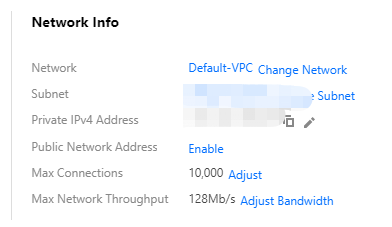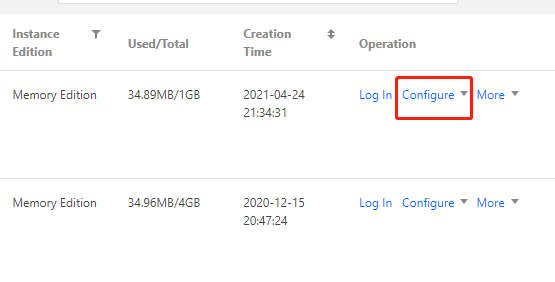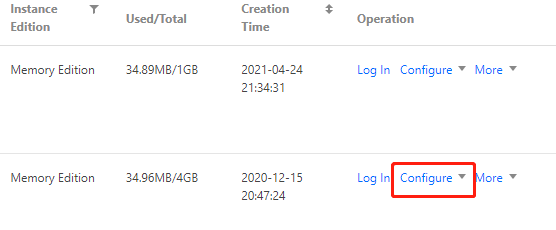- Release Notes and Announcements
- User Tutorial
- Product Introduction
- Purchase Guide
- Getting Started
- Operation Guide
- Operation Overview
- Access Management
- SDK Connection
- Daily Instance Operation
- Viewing Instance Information
- Assigning Instance to Project
- Editing Instance Tag
- Setting Maintenance Time
- Changing Instance Specification
- Adjusting the Number of Connections
- Enabling/Disabling Read/Write Separation
- Clearing Instances
- Returning and Isolating Instance
- Restoring Isolated Instance
- Eliminating Instance
- Instance Upgrade
- Node Management
- Multi-AZ Deployment Management
- Backup and Restoration
- Data Migration
- Account and Password
- Parameter Configuration
- Slow Log
- Network and Security
- Monitoring and Alarms
- Event Management
- Global Replication
- Performance Optimization
- Sentinel Mode
- Development Guidelines
- Command Compatibility
- Troubleshooting
- Best Practices
- API Documentation
- History
- Introduction
- API Category
- Making API Requests
- Instance APIs
- AddReplicationInstance
- AllocateWanAddress
- ChangeInstanceRole
- ChangeMasterInstance
- CleanUpInstance
- ClearInstance
- CloseSSL
- CreateInstanceAccount
- CreateReplicationGroup
- DeleteInstanceAccount
- DeleteReplicationInstance
- DescribeAutoBackupConfig
- DescribeBandwidthRange
- DescribeInstanceAccount
- DescribeInstanceDTSInfo
- DescribeInstanceZoneInfo
- DescribeInstances
- DescribeProxySlowLog
- DescribeSlowLog
- DescribeTendisSlowLog
- DestroyPostpaidInstance
- DestroyPrepaidInstance
- DisableReplicaReadonly
- EnableReplicaReadonly
- InquiryPriceCreateInstance
- InquiryPriceUpgradeInstance
- KillMasterGroup
- ModifyAutoBackupConfig
- ModifyInstance
- ModifyInstanceAccount
- ModifyInstanceReadOnly
- ModifyMaintenanceWindow
- ModifyNetworkConfig
- OpenSSL
- ReleaseWanAddress
- RenewInstance
- ResetPassword
- StartupInstance
- SwitchProxy
- UpgradeInstanceVersion
- UpgradeProxyVersion
- UpgradeSmallVersion
- UpgradeVersionToMultiAvailabilityZones
- DescribeCommonDBInstances
- ChangeReplicaToMaster
- CloneInstances
- CreateInstances
- DescribeInstanceDealDetail
- DescribeInstanceNodeInfo
- DescribeInstanceShards
- DescribeMaintenanceWindow
- DescribeParamTemplateInfo
- DescribeReplicationGroup
- DescribeSSLStatus
- DescribeTaskInfo
- DescribeTaskList
- ModfiyInstancePassword
- RemoveReplicationInstance
- UpgradeInstance
- DescribeInstanceEvents
- ModifyInstanceAvailabilityZones
- ModifyInstanceEvent
- SwitchAccessNewInstance
- DescribeInstanceSupportFeature
- Parameter Management APIs
- Other APIs
- Region APIs
- Monitoring and Management APIs
- Backup and Restoration APIs
- Data Types
- Error Codes
- FAQs
- Service Agreement
- Glossary
- Contact Us
- Release Notes and Announcements
- User Tutorial
- Product Introduction
- Purchase Guide
- Getting Started
- Operation Guide
- Operation Overview
- Access Management
- SDK Connection
- Daily Instance Operation
- Viewing Instance Information
- Assigning Instance to Project
- Editing Instance Tag
- Setting Maintenance Time
- Changing Instance Specification
- Adjusting the Number of Connections
- Enabling/Disabling Read/Write Separation
- Clearing Instances
- Returning and Isolating Instance
- Restoring Isolated Instance
- Eliminating Instance
- Instance Upgrade
- Node Management
- Multi-AZ Deployment Management
- Backup and Restoration
- Data Migration
- Account and Password
- Parameter Configuration
- Slow Log
- Network and Security
- Monitoring and Alarms
- Event Management
- Global Replication
- Performance Optimization
- Sentinel Mode
- Development Guidelines
- Command Compatibility
- Troubleshooting
- Best Practices
- API Documentation
- History
- Introduction
- API Category
- Making API Requests
- Instance APIs
- AddReplicationInstance
- AllocateWanAddress
- ChangeInstanceRole
- ChangeMasterInstance
- CleanUpInstance
- ClearInstance
- CloseSSL
- CreateInstanceAccount
- CreateReplicationGroup
- DeleteInstanceAccount
- DeleteReplicationInstance
- DescribeAutoBackupConfig
- DescribeBandwidthRange
- DescribeInstanceAccount
- DescribeInstanceDTSInfo
- DescribeInstanceZoneInfo
- DescribeInstances
- DescribeProxySlowLog
- DescribeSlowLog
- DescribeTendisSlowLog
- DestroyPostpaidInstance
- DestroyPrepaidInstance
- DisableReplicaReadonly
- EnableReplicaReadonly
- InquiryPriceCreateInstance
- InquiryPriceUpgradeInstance
- KillMasterGroup
- ModifyAutoBackupConfig
- ModifyInstance
- ModifyInstanceAccount
- ModifyInstanceReadOnly
- ModifyMaintenanceWindow
- ModifyNetworkConfig
- OpenSSL
- ReleaseWanAddress
- RenewInstance
- ResetPassword
- StartupInstance
- SwitchProxy
- UpgradeInstanceVersion
- UpgradeProxyVersion
- UpgradeSmallVersion
- UpgradeVersionToMultiAvailabilityZones
- DescribeCommonDBInstances
- ChangeReplicaToMaster
- CloneInstances
- CreateInstances
- DescribeInstanceDealDetail
- DescribeInstanceNodeInfo
- DescribeInstanceShards
- DescribeMaintenanceWindow
- DescribeParamTemplateInfo
- DescribeReplicationGroup
- DescribeSSLStatus
- DescribeTaskInfo
- DescribeTaskList
- ModfiyInstancePassword
- RemoveReplicationInstance
- UpgradeInstance
- DescribeInstanceEvents
- ModifyInstanceAvailabilityZones
- ModifyInstanceEvent
- SwitchAccessNewInstance
- DescribeInstanceSupportFeature
- Parameter Management APIs
- Other APIs
- Region APIs
- Monitoring and Management APIs
- Backup and Restoration APIs
- Data Types
- Error Codes
- FAQs
- Service Agreement
- Glossary
- Contact Us
High Outbound Traffic
Last updated: 2021-09-13 10:49:34
Error Description
- Symptom 1: you received an alarm about the outbound traffic being restricted because the outbound traffic metric reached the maximum value allowed.
- Symptom 2: the response latency increased.
Possible Reasons
The reasons are as follows:
- Big keys
- Insufficient instance configuration
Solutions
- Adjust the bandwidth of the instance in the TencentDB for Redis console to alleviate the problem.
- Check and optimize big keys in the following ways:
- Split big keys.
- Have less access to big keys as long as your business won't be affected.
- Delete useless big keys.
- If the bandwidth upper limit problem persists after optimization, upgrade the instance to improve its ability to handle more traffic.
Troubleshooting Procedure
Step 1. Adjust the bandwidth
- Log in to the TencentDB for Redis console, click an instance ID in the instance list, and enter the instance details page.
- Adjust the bandwidth in the Network Info block (the additional bandwidth is currently free of charge).
Note:
- Increasing bandwidth has no impact on your business. However, if the bandwidth is decreased, the traffic which exceeds the bandwidth may be restricted.
- Standard bandwidth: it is the bandwidth per (master or replica) node in the instance.
- Read-Only replica bandwidth: each read-only replica has the same bandwidth as that of the master.
- Additional bandwidth: if the standard bandwidth cannot meet your needs, you can add additional bandwidth.
- Total instance bandwidth = additional bandwidth * the number of shards + standard bandwidth * the number of shards * the number of replicas. (There is one shard in standard architecture. If the instance has no replica, the number of replica in this formula is one.)

Step 2. Optimize big keys
- Log in to the TencentDB for Redis console, click an instance ID in the instance list, and enter the instance management page.
- On the System Monitoring tab, view the key size distribution chart and optimize big keys in the following ways:
- Split big keys.
- Have less access to big keys as long as your business won't be affected.
- Delete useless big keys.
If the bandwidth upper limit problem persists, go to Step 3. Upgrade the instance.
Step 3. Upgrade the instance
Upgrading a Memory Edition instance in standard architecture
Note:
- After the configuration is adjusted, the instance will be charged at the price of the new configuration.
- To expand the capacity of a Memory Edition instance in standard architecture, if the remaining available capacity of the physical machine is insufficient, a migration will occur, which will not affect your access to the instance. However, if the instance is running Redis 2.8, a flash disconnection will occur after the migration is completed, so we recommend that your business have a reconnection mechanism.
- As the maximum capacity of a Memory Edition instance in standard architecture is 64 GB, you cannot expand its capacity to more than 64 GB.
- Log in to the TencentDB for Redis console, locate the desired instance in the instance list, and select Configure > Expand Node or Add Replica in the Operation column.

- In the pop-up dialog box, adjust the configuration and click OK.
- Return to the instance list. After the status of the instance changes to "Running", the instance can be used normally.
Upgrading a Memory Edition instance in cluster architecture
Note:
- After the configuration is adjusted, the instance will be charged at the price of the new configuration.
- When shards are added, the system will automatically balance the slot configuration and migrate data.
- During capacity expansion and reduction, such blocking commands as
BLPOP,BRPOP,BRPOPLPUSH, andSUBSCRIBEmay fail once or more (which is related to the number of shards). Please assess the impact on your business before starting capacity expansion and reduction.
- Log in to the TencentDB for Redis console, locate the desired instance in the instance list, and select Configure > Add Shard, Expand Node, or Add Replica in the Operation column.

- In the pop-up dialog box, adjust the configuration and click OK.
- Return to the instance list. After the status of the instance changes to "Running", the instance can be used normally.

 Yes
Yes
 No
No
Was this page helpful?